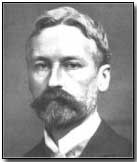Who's Who - Henry Nevinson
 Henry Nevinson (1856-1941)
reported the war from the Gallipoli and Western Fronts during the First
World War.
Henry Nevinson (1856-1941)
reported the war from the Gallipoli and Western Fronts during the First
World War.
A foreign correspondent of the Daily Chronicle from 1897 Nevinson gained renown for his coverage of the South African War of 1899-1902. Having thus established a brilliant reputation with subsequent reporting of the slave trade in Portuguese Angola Nevinson was a natural choice as war correspondent upon the outbreak of war in Europe in 1914.
However Nevinson's ultra-liberal views - he fully endorsed the notion of female suffrage - did not endear him to Asquith's wartime administration. As a consequence Nevinson was not in fact initially given accreditation to cover the war from the front line.
In time however Nevinson reported the war from first hand in Gallipoli and, later, from the Western Front. In the former campaign he played his part in attempting to stop the Australian correspondent Keith Murdoch from hand delivering to Prime Minister Asquith a letter from fellow correspondent Ellis Ashmead-Bartlett.
The letter was scathing in its condemnation of Sir Ian Hamilton's conduct of the Gallipoli campaign; although Nevinson conceded Ashmead-Bartlett his right to hold such views he nevertheless considered his circumvention of the military censorship rules a betrayal of trust with Hamilton (who was more forward looking than most commanders with regard to war correspondents).
Consequently Nevinson tipped off the French police at Marseille of Murdoch's arrival en route for London, with the result that Ashmead-Bartlett's letter was confiscated (for nought; Murdoch proceeded to London and effectively regurgitated Ashmead-Bartlett's letter from memory).
Wounded in the course of his reporting Nevinson, ever the radical, declined the offer of a knighthood with the armistice. He served from 1939 as President of the Council for the Defence of Civil Liberties.
He died in 1941. His son, Christopher, became a famous war artist of similarly radical views.
Click here to read Nevinson's views on the failed Allied attempt upon the Dardanelles Narrows on 18 March 1915.
A 'corkscrew' was a metal post for supporting a wire entanglement, with a twisted base enabling it to be screwed into the ground, removing the need for a hammer, the use of which could attract enemy fire.
- Did you know?
